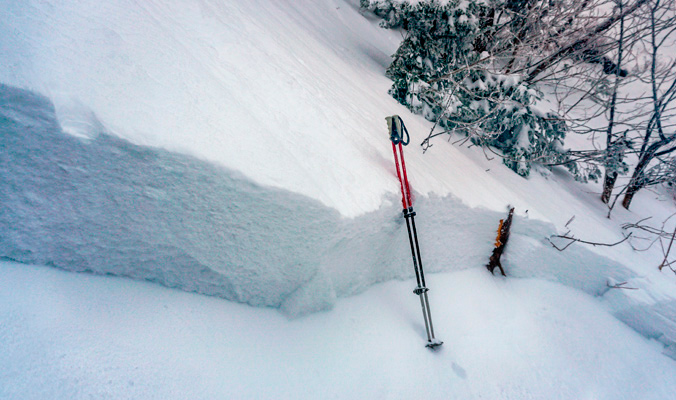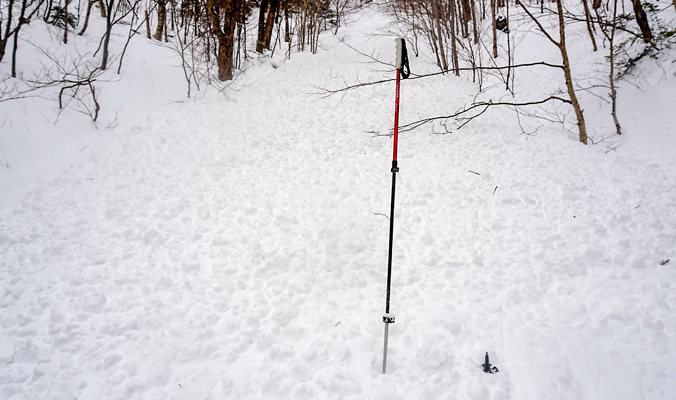Avalanches in Vermont are considered as uncommon as getting the measles. But in March 2018, Vermont residents Aaron Rice, 28, who notably climbed and skied 2.5-million vertical feet in 2016, and friend Cyril Brunner, 27, found themselves dealing with one in Smugglers’ Notch, near Stowe Mountain Resort. The accident wasn’t just because of their line choice and a snowpack with buried facets beneath feet of new snow, but also due to common heuristic traps that can befall skiers anywhere.
The duo aimed to find exposure and untracked snow in one of the areas of Vermont where dense forest gives way to couloirs, cliffs and steeps, but an assumption of an avalanche-free East Coast kept them from identifying warning signs. And in a world where more people push past ski resort boundaries, the eastern safety bubble can burst quickly.

One-to-two-foot crown lines along the flanks of a 2018 avalanche in Smugglers’ Notch Vt. [Photo] Aaron Rice
Aaron Rice: Generally we don’t plan our days very far in advance. I was texting back and forth with Cyril the night before, because it had just snowed a bunch. We were talking about doing this big line that Cyril had been talking about skiing all year—a line he’d skied before. So we decided to head to the Notch to try it.
Cyril Brunner: From the standpoint of trying to find something to ski on a pow day on the East Coast, it can be challenging to find something steep enough. The Notch presented that as an option. That was a clear trap right there, but because of where we were [geographically], we weren’t really thinking about avalanches.
AR: The Notch is a sidecountry zone, and it’s got some mellow back bowls you can get to from the [Stowe Mountain Resort] lift. It’s also got some much more aggressive lines you have to hike to with full-on couloirs and avalanche paths.
CB: We decided to meet and take the Stowe gondola up to the top and ski from the summit first before heading to the line, which is hard to get to. On that day, we got completely disoriented, because the visibility was poor, and we ended up skiing off the wrong side of the mountain.
CB: Since we ended up taking the first run off the wrong side of Mt. Mansfield, we missed an opportunity to assess snow on the aspect we were planning to ski. When we made it back over the mountain, the top of the line we were planning on skiing to get to the main objective already had tracks in it so we couldn’t see how reactive the snow would be.
AR: We also had four people in the group, and in skiing off the back, we burned two or three hours of time. All of a sudden, what people thought was going to be an hour-and-a-half sidecountry lap turned into a huge mission. People were tired and not ready to make hard decisions in avalanche terrain.
We also hadn’t seen the snow because we took the lift up instead of skinning, so we’d put ourselves at the top of a line without having seen any snow from that day.
CB: Once we made it over to the line, which took a significant amount of bushwhacking through deep snow without any real turns, Aaron and I made it to the line first.
I was in front and skied directly across the top of the line, where there was quite a bit of exposure above me because of an icefall. I cut across, and I think that was when it triggered in Aaron’s head, “Whoa, dude. Slow down.” But at that point I was already across. Luckily nothing happened at that point. It could have, and it would have been bad. The other two people were still skiing through the woods, so it was just Aaron and me.
AR: Cyril cut across the line, and I had this initial thought, “Whoa. This is avalanche terrain. Don’t do that.” But obviously that was not a full thought, because none of us had avalanche gear, and I didn’t really think about what would actually happen if there was an avalanche. It was more of the hundreds and hundreds of days spent in avalanche terrain kicking in, where if you’re in avalanche terrain, you follow certain protocols. I even absent-mindedly dug a hand pit and saw some reaction, but I was just interested in the snow. Avalanches were so far from my East Coast mindset that it didn’t register as a real threat.
So this far, we can identify three or four heuristic traps we fell into: familiarity, expert halo—Cyril had skied the line before—we had scarcity in the beginning when we were looking for untracked powder, and we ended up rushing because we got lost.
CB: The other two people in the group skied closer, and Aaron and I were talking about doing a ski cut and where to do it. As I did a ski cut back toward Aaron, that’s when things happened.
AR: He did a slope cut back to me, and then one more back to the other side with no reaction. That’s when Cyril decided to ski. He made one right turn, and that turn was on a rollover and the whole thing fractured. Luckily, he’d made the turn already, so he was able to quickly exit the chute at a 45-degree angle and ended up in a safe spot in the trees.

East Coast carnage: the four- to six-foot debris pile. [Photo] Aaron Rice
CB: The entire slope went. I had my back to it, and Aaron was shouting in the background. I remember seeing a big plume of snow and the entire slope ripped away.
AR: I knew the chute had cleaned itself out, but I didn’t know how big the crowns were going to be. After the avalanche went, I switched into management mode and realized that we were in avalanche terrain and now we need to get out. As we were skiing down, it got worse. One person fell and lost a ski, and while attempting to catch the ski that was headed downhill, Cyril lost his ski in the process.
The situation started to deteriorate, so we re-grouped and decided to ski conservatively, because we were skiing bulletproof bed surface. We talked about climbing back up, but we decided that because of time and because the line had already ripped, we should keep going down. There were all of these chutes that funnel into the main drainage, and each of those had a two-foot crown, so we were aware to not ski on those and trigger more. We got to a big waterfall and tried to ski around it through another chute, but the smaller chute still had snow. We were worried about triggering that too, so we ended up skinning up between the two chutes and bumping over to what we hoped would be a safe zone and a way out.
We hit the Notch Road and instantly bumped into a group of friends who’d come down the other side and were super stoked. And there we were, stone-faced and shaken. The four of us aren’t a group of people who would hang out very often, so I had this conscious realization that we should debrief right then and there, even before we skated out the Notch Road. We talked about what mistakes were made, what we did well, and I think it was good for me to have that instant reality check.
CB: I took the backcountry for granted and ignored prior experience because of complacency and comfort I’ve developed over my years spent in the East.
AR: I knew we were in avalanche terrain and knew the snowpack was somewhat unstable, but I didn’t listen to what my experience was telling me. From that, I learned to not underestimate the East and Vermont. Whether it’s avalanches or general hazards of traveling in the backcountry, just because it’s your backyard doesn’t mean you can’t get into trouble.











That’s an area I know fairly well from Hiking the LT and riding Smuggs. Can we confirm this was on Hell Brook? Sounds like it…
David, I am pretty sure they are talking about a bit higher up the notch.
Yeah, definitely not Hell Brook. That’s not steep enough except for very short pitches, and gets way too much traffic to ever build up a sliding surface.
Cliffs, steeps, sidecountry, back bowls, no avalanche gear, lost skis, this is an East Coast epic. Only missing references to maple syrup, glades, and the tight knit community. Thanks for sharing